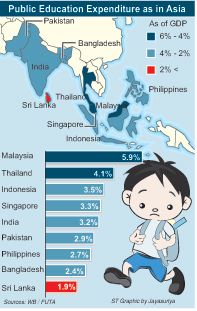Education: Is it serving us efficiently?
In 1944 C.W.W. Kannangara, Minister of Education moving the ‘Free Education Bill ‘declared; “Sir, . How much nobler – when we shall be able to say that we found education dear and left it cheap, that we found it a sealed book and left it an open letter, we found it the patrimony of the rich and left it the inheritance of the poor” (Hansard 1944 pp 916-46).
The new education system was expected to ensure that education was provided with equal opportunities for all children irrespective of social class, economic condition, religion and ethnic origin. A Special Committee was appointed in 1942 with Kannangara as Chairman to report on the status of education. This Committee made far reaching recommendations for providing “lasting value to the nation”. Among them the following was prominent.
Education should be free from the Kindergarten to the University; and
A curriculum for the child which would develop its “head, heart and hands” should be introduced. In other words, the education of the emotions is as necessary as the education of intellect and practical ability for the well-being of the child. I am a 100 per cent product of free education. I received my basic education in an unsung, unheard village school at Getambe, Kandy. Parents of my classmates were humble low income earners with no influence. They were all wage earners or self employed. My classmates had talents for music, dancing, sports, farming, writing, oration etc. Some had a knack for crafty things. Some were fearless, courageous and forthright. I cannot think of any such talent I was gifted with. But, only three including myself out of my 45 classmates managed to get admission to the university. The rest, except a few who have become school teachers and clerks, have ended up as wage earners like their parents. They have completed the full cycle to reach where they started the life. Was “picking up 3 (7%) winners and dropping out 42 (93%) as losers” the expectation of the father of free education?
I entered Kingswood College, a well known elite school for my secondary education. My experience in Kingswood College was different. We had the same number of classmates. Their parents were elite, rich with connection, influence and power. They were the employers of parents of my classmates at the village school. Again the same number of my classmates (3) entered the university. What happened to the rest? They are all doing well not thanks to free education but to their social background. I made this comparison to show that education alone does not work as a social leveler as many believe. Education raises expectations of parents and children and drops the majority of them half way through. They are the so-called drop-outs whose hopes were dashed and shattered. Only a fraction makes it through education pushing the majority back to where they were. Education has made more than 90 per cent Sri Lankans literate and knowledgeable. At the same time, education leaves behind more than 90 per cent of students every year. Education drops out more than 10-folds of what it takes up the ladder. Education picks winners (much less in number) but not the losers. Parents invest in education with the sole expectation of social elevation (or is it emancipation?). Only a fraction realizes it. Has the education worked as a social-leveler for the majority? It works as a social leveler at the entry but not at the exit. It takes equals in and puts out in-equals. Children while in school are bright, courageous, ambitious and promising but once left are desperate, pessimistic, and broken persons.The Kannangara Committee thought education would add “a lasting value to the nation”. Education should be a means to an end.Education could play this role in two ways. Firstly sharpening skills and talents and putting out a demanding employable human resource. This will realize expectations of both the parents and the society. Secondly that output should contribute to mitigate inequality to reduce the need for a social leveler. This means the socio economic advancement of the nation/society. In my opinion we have failed in both. The output of the education can contribute to national development only by being productively employed in gainful opportunities. Education has not helped the majority in getting employed. Even our university graduates except in a few streams such as Medicine and Engineering are not in much demand. The corporate sector prefers lesser educated urban based youth with extracurricular activities and skills. The public sector is overstaffed with no room for creation of additional effective employment avenues.
On the other hand the fraction that succeeded and employed evidently has not worked for mitigating the social inequality. Sri Lanka was at par or ahead of its Asian neighbours such as Korea, Malaysia, and Singapore in 1950s and today, after enjoying 70 years of free education, we are behind. Has education and training catered to our needs? Have we adapted ourselves to the trends and needs of a new millennium and the global village? We need a social leveler as long as there is an inequality. Are we suggesting maintaining inequality and looking for social levelers such as education? We take the easy path of maintaining the inequality and do some tinkering with free education. Is it because education has produced “tinkers” but not “thinkers”? Perhaps we have taken the wrong end of the stick once again. Those who have succeeded cite their personal achievement to prove the merits of free education as a social-leveler. It is true for a fraction but unfortunately missing the wood for trees. They do not see the plight of those who could not make it.
Kannangara thought that education would develop “head, heart and hands”. In brief he talked of an integrated wholesome education system. But, we have disintegrated and created three separate ministries and nine provincial ministries in charge of education adding the chaos to confusion. When a commodity is free, the market will be supplier-dominated. Consumer (students and parents) is not free to choose. It is necessary to make the market consumer dominated. This can be achieved through mitigation of inequity enabling education affordable to majority. On the other hand, education is free in theory but not so in practice. Parents pay for education through higher indirect taxes. How many of our parents have sacrificed their meals and mortgage their jewellery and property to educate us?There is a social element and a commercial element in education. It is necessary to separate these two out and increase its return on investment. The examinations have become an instrument for elimination rather than for accommodating.
Since the Kannangara reforms, no major comprehensive long lasting reforms in the education sector have been introduced except during 1970 – 77 period. The White Paper introduced by Ranil Wickremasinghe as Minister of Education did not receive the attention it deserved. No reviews on education have been conducted; No assessment has been made on value addition of education. In the immediate aftermath of its introduction, free education served as a ladder to reach higher social and economic status; it enabled getting employment. Can we pass the same judgment after 70 years of its existence? There has been no adequate and thorough discussion, dialogue or debate on status, trends, needs and direction of education. Dr. M. U. Sedera in “Context of Educational Reforms Then and Now” has to say this:
“Dr. C.W.W. Kannangara is identified by all Sri Lankans as the father of Free Education. He was the architect of the 1944 educational reforms in Sri Lanka which opened the doors of education for all and Sri Lanka has progressed well since then. Today after six decades, the context of the 1944 reforms is much changed, yet Sri Lanka continues to provide the same type of free education. In the last six decades Sri Lanka has achieved a very high level of Human Development both in education and health sectors. Moreover the socioe-conomic context of Sri Lanka as well as the world has significantly changed”. This is exactly where we are. We are at cross-roads. Do we continue to carry the legacy of free education? Or do we critically look at it with wide open eyes? In this background, FUTA has proposed allocation of 6 per cent of GDP for education. I am not sure of the size of the allocation and how and where it came from. But this suggestion of FUTA has sparked off the long awaited dialogue on education. This has become the talking point across the society from the President downwards to the man on the street. We are happy and grateful that FUTA has broken the silence which prevailed on education reforms for over 70 years.
We are all the products of free education. We as policy makers, politicians, programme executors and teachers should take the responsibility for the present status of education as well as the economy. The issues in education are much larger than we think and go much beyond “Free Education” or “State Education”. We continue to talk of “Free Education” or “State Education” as tinkers not as thinkers. Percentage is only a number. Mere increase in the allocation is not enough. What is needed most is a comprehensive way forward education policy reforms and a programme to meet the aspirations of a nation in the 21st Century? Now that FUTA has initiated a dialogue on education, FUTA as the cream of the intelligentsia and the society and being the product of the free education could lead the drive for far reaching and long lasting educational reforms to match the local needs and global trends. Finally I wish to remind those who believe of “no political interference in education” that the only education reforms introduced in this country were introduced by a politician, Kannangara. Concerns and questions should be raised as to what is education for. Is it for literacy and knowledge only or for building up skillful entrepreneurial human resource which would take the nation forward with social and economic advancement? Continuation in its present form will not be the answer. How do we mitigate inequality and make education affordable to the majority? FUTA states that passing the legacy of free education to the next generation is also a pleasure. But, mere passing of a product introduced 70 years ago simply will not help. We must look at different models for funding, private public partnership, cost efficiency and cost sharing, accessibility and affordability, well paying back investment etc.
(The writer is a retired government official and former Secretary to several ministries. He can be reached at c_maliyadde@yahoo.com)
Follow @timesonlinelk
comments powered by Disqus




















